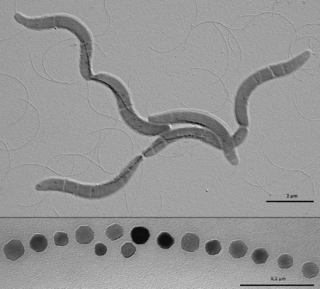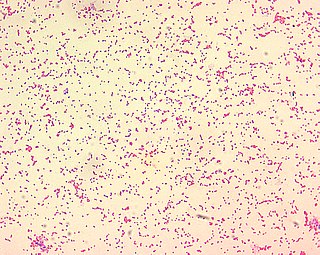Related Research Articles

The Rhodospirillales are an order of Pseudomonadota.
The Thermoprotei is a class of the Thermoproteota.

The Rhizobiaceae is a family of Pseudomonadota comprising multiple subgroups that enhance and hinder plant development. Some bacteria found in the family are used for plant nutrition and collectively make up the rhizobia. Other bacteria such as Agrobacterium tumefaciens and Rhizobium rhizogenes severely alter the development of plants in their ability to induce crown galls or hairy roots, respectively. The family has been of an interest to scientists for centuries in their ability to associate with plants and modify plant development. The Rhizobiaceae are, like all Pseudomonadota, Gram-negative. They are aerobic, and the cells are usually rod-shaped. Many species of the Rhizobiaceae are diazotrophs which are able to fix nitrogen and are symbiotic with plant roots.

The Hyphomicrobiales are an order of Gram-negative Alphaproteobacteria.

The Brucellaceae are a family of the Gram-negative Hyphomicrobiales. They are named after Sir David Bruce, a Scottish microbiologist. They are aerobic chemoorganotrophes. The family comprises pathogen and soil bacteria

Desulfovibrionales are a taxonomic order of bacteria belonging to the phylum Thermodesulfobacteriota, with four families. They are Gram-negative. The majority are sulfate-reducing, with the exception of Lawsonia and Bilophila. All members of this order are obligately anaerobic. Most species are mesophilic, but some are moderate thermophiles.
The Syntrophobacterales are an order of Thermodesulfobacteriota. All genera are strictly anaerobic. Many of the family Syntrophobacteraceae are sulfate-reducing. Some species are motile by using one polar flagellum.

In taxonomy, the Thermoplasmata are a class of the Euryarchaeota.

In taxonomy, the Thermoplasmataceae are a family of the Thermoplasmatales. It contains only one genus, Thermoplasma. All species within Thermoplasmataceae are thermoacidophiles, and they grow at a temperature of 60°C and pH 2. They were isolated from hydrothermal vents, fumaroles and similar environments.

In taxonomy, the Thermoplasmatales are an order of the Thermoplasmata. All are acidophiles, growing optimally at pH below 2. Picrophilus is currently the most acidophilic of all known organisms, being capable of growing at a pH of -0.06. Many of these organisms do not contain a cell wall, although this is not true in the case of Picrophilus. Most members of the Thermotoplasmata are thermophilic.

In the taxonomy of microorganisms, the Methanomicrobia are a class of the Euryarchaeota.

In taxonomy, the Acidilobales are an order of the Thermoprotei.

The Desulfurococcales are an order of the Thermoprotei, part of the kingdom Archaea. The order encompasses some genera which are all thermophilic, autotrophs which utilise chemical energy, typically by reducing sulfur compounds using hydrogen.

In taxonomy, the Methanosarcinaceae are a family of the Methanosarcinales.
Methanocaldococcus formerly known as Methanococcus is a genus of coccoid methanogen archaea. They are all mesophiles, except the thermophilic M. thermolithotrophicus and the hyperthermophilic M. jannaschii. The latter was discovered at the base of a “white smoker” chimney at 21°N on the East Pacific Rise and it was the first archaean genome to be completely sequenced, revealing many novel and eukaryote-like elements.
Phyllobacterium is a genus of Gram-negative, oxidase- and catalase-positive, aerobic bacteria.
Ancylobacter is a genus of aerobic bacteria from the family of Xanthobacteraceae.
Desulfitobacterium is a genus of Gram-positive, strictly anaerobic, rod-shaped, spore-forming bacteria from the family of Peptococcaceae. Desulfitobacterium species have low GC-contents.
Desulfonatronum is a Gram-negative and extremely alkaliphilic bacteria genus from the family of Desulfovibrionaceae.
Syntrophus is a Gram negative bacterial genus from the family of Syntrophaceae.
References
- 1 2 3 4 LPSN lpsn.dsmz.de
- ↑ UniProt
- ↑ Garrity, George M., ed. (2005). Bergey's manual of systematic bacteriology (2nd ed.). New York: Springer. ISBN 0-387-24145-0.
- ↑ Falkow, Stanley, ed. (2006). Proteobacteria: Alpha and Beta subclasses (3rd ed.). New York: Springer. ISBN 0-387-25495-1.
- ↑ Hördt A, García López M, Meier-Kolthoff JP, Schleuning M, Weinhold L, Tindall BJ, Gronow A, Kyrpides NC, Woyke T, Göker M (2020). "Analysis of 1,000+ Type-Strain Genomes Substantially Improves Taxonomic Classification of Alphaproteobacteria". Front. Microbiol. 11: 468. doi: 10.3389/fmicb.2020.00468 . PMC 7179689 . PMID 32373076.